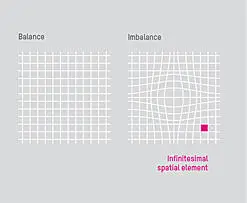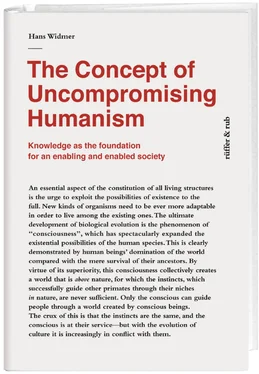A new “unexpected approach” must proceed on the assumption that
1.Physics is freely invented, not discovered in nature like hidden Easter eggs or the ideas of Plato (cf. Einstein’s notion that the concepts that occur in our minds are all free inventions);
2.These inventions are initially random hypotheses and only gain validity if they have passed through the eye of the experimental verification needle (like mutation and selection in evolution);
3.Space, time and causality are components of the system of thought—not of the world that is the subject-matter of that thought;
4.Perception is the basis of all knowledge—even if the most abstract mathematics is mounting up;
5.A continuum in space and time, in particular, is an inevitable necessity of thought;
6.There are hierarchies of knowledge whose higher levels do not arise from accumulation or abstraction, but—like concepts—are initially invented as hypotheses with their worth proved by the possibility that lower level laws and constants can be derived from them (hyperstases).
The logically essential continuum of deductive physics
The continuum does not remain a mere idea (as with Descartes) or something hidden away in mathematics (as with Einstein), but is the equivalent of a gas at a constant temperature2 (physics: “isothermal”), which is already implied by the equations of the theory of relativity; the continuum is specified by the fundamental constants3 c, G, and ħ and it explains that which inductive physics simply has to accept, namely why:
–Interactions do not happen instantaneously,
–Gravity and electromagnetism have the same velocity of propagation,
–Interferences at atomic distances bring about quantum mechanical phenomena,
–Interferences at distances of the magnitude of the elementary particle radius (Compton length) bring about the strong interaction.
In deductive physics, the dynamics of masses provides the starting point for all explanations of elementary particles, while inductive physics has not succeeded in bridging the gap between the macroscopic and elementary particles. N.B.: The continuum does not explain what it actually is—apart from indirectly through its functionality as a substrate for the idea of the material world. Those who can imagine the dynamics of the continuum have laid the foundations for all further understanding.
Dynamics of the specific continuum
Viewing the universe as filled by a continuum means that every microscopic spatial element is connected to the next, and that the connections extend across the whole of space.
Two intuitively logical accounts of a spatial element of this kind are used to determine the dynamics from which everything concerning inertia and gravity through to the theory of relativity can be derived:
–An account of the development of the density of the continuum as a result of flow: the density increases or decreases as more continuum enters or leaves. Formalising this logic gives what is known as the continuity equation4;
–An account of the development of flow as a result of downward density gradients. How does flow accelerate if at a point in space there is a drop in pressure? Pressure “wants to” level out, which triggers flow. The result is the Euler equation5, which states that the acceleration is proportional to a drop in pressure: the steeper the drop, the faster the acceleration—like when riding a bike.

Disturbance in the continuum
All the beauty, and an idea of the consequences, of this simple formulation of intuitive logic emerge on calculation of how a local pressure difference (in physics: “disturbance”) spreads vis-à-vis the smooth continuum at rest. As both “accounts” must be balanced simultaneously, there are two equations with two unknowns (density, velocity). Feeding one into the other results in a wave equation.6

Continuity
As with a pendulum, which alternates between the development of greater height or greater velocity, in a continuum there is more pressure or more flow. This imbalance moves off as a wave, because each communicates with the other, with a delay. The velocity of propagation of disturbances emerges from the solution of the wave equation; in a gas such as air this is the speed of sound . In the specific continuum this corresponds to the speed of light . As gravitational, electrical and electromagnetic fields are disturbances in the continuum, they all expand at the speed of light7. If the sun were to vanish instantaneously from the universe, not only would it go dark on Earth after 500 seconds, but the Earth would simultaneously fly out of its orbit.
Simply from the assumption of the specific continuum, mass can be reconstructed as dynamics of the continuum. Mass need no longer be considered as a corpuscle, thereby removing the insoluble puzzle of what constitutes the corpuscle. The single available “building block” of deductive physics is the continuum:
–The dynamics of masses is a pulsing of the continuum: it flows to a point8, then re-emerges in waves9 (inversely to the situation at the beach, where water rolls in as waves and returns to the sea as a flow).
– Inertia 10 arises from the work needed to compress the inflow field to a mass (“Lorentz contraction”), that is associated with a relative velocity v vis-à-vis the continuum at rest.
– Gravity 11 arises from the impact of the outgoing waves on inflow from a distant mass, in the same way as sources in any continuum attract sinks.
– Equivalence principle 12: Einstein looked for the form of the laws that remains unchanged in accelerated coordinate systems; he called this the “equivalence principle”. It makes no difference to a mass whether it has a velocity relative to the continuum at rest or if it is in the inflow of another mass: the “headwind” is the same. The formulae are also the same, but for the fact that instead of kinetic energy, potential energy is used.
– Theory of relativity 13 – the results are side effects of the dynamics of masses: contraction of inflow and radiation fields change wavelengths and consequently frequencies.
– Black holes 14 occur when such huge quantities of mass have accumulated in a galaxy that the outgoing waves can no longer overcome the inflow; as a result they continuously draw in continuum together with the stars contained therein.

*
– Universe 15: The distance between galaxies is constantly expanding, indicated by red shift of the light received on Earth from very distant stars (like the deepening tone of a motorbike as is moves away from the listener). This expansion has also been essential in preventing the galaxies in the universe from clumping together long ago. The idea that “the universe is expanding” implies:
– Empty space: as the universe expands into a space where nothing was before, and where it was there is now less of it;
– Permanence: one and the same universe remains in place, but is redistributed in space;
– A continuum: as the expansion movement is shared with the whole and is inconceivable without a continuum,
Читать дальше















